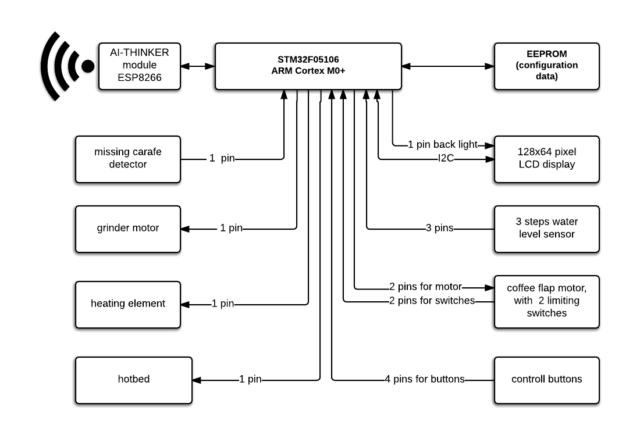With the name Smarter, you might expect a network-connected kitchen appliance maker to be, well, smarter than companies selling conventional appliances. But in the case of the Smarters Internet-of-things coffee maker, youd be wrong.
As a thought experiment, Martin Hron, a researcher at security company Avast, reverse engineered one of the $250 devices to see what kinds of hacks he could do. After just a week of effort, the unqualified answer was: quite a lot. Specifically, he could trigger the coffee maker to turn on the burner, dispense water, spin the bean grinder, and display a ransom message, all while beeping repeatedly. Oh, and by the way, the only way to stop the chaos was to unplug the power cord. Like this:
“Its possible,” Hron said in an interview. “It was done to point out that this did happen and could happen to other IoT devices. This is a good example of an out-of-the-box problem. You don't have to configure anything. Usually, the vendors dont think about this.”
What do you mean “out-of-the-box”?
When Hron first plugged in his Smarter coffee maker, he discovered that it immediately acted as a Wi-Fi access point that used an unsecured connection to communicate with a smartphone app. The app, in turn, is used to configure the device and, should the user choose, connect it to a home Wi-Fi network. With no encryption, the researcher had no problem learning how the phone controlled the coffee maker and, since there was no authentication either, how a rogue phone app might do the same thing.
That capability still left Hron with only a small menu of commands, none of them especially harmful. So he then examined the mechanism the coffee maker used to receive firmware updates. It turned out they were received from the phone with—you guessed it—no encryption, no authentication, and no code signing.
These glaring omissions created just the opportunity Hron needed. Since the latest firmware version was stored inside the Android app, he could pull it onto a computer and reverse engineer it using IDA, a software analyzer, debugger, and disassembler thats one of a reverse engineers best friends. Almost immediately, he found human-readable strings.
“From this, we could deduce there is no encryption, and the firmware is probably a plaintext image that is uploaded directly into the FLASH memory of the coffee maker,” he wrote in this detailed blog outlining the hack.
Taking the insides out
To actually disassemble the firmware—that is, to transform the binary code into the underlying assembly language that communicates with the hardware, Hron had to know what CPU the coffee maker used. That required him to take apart the device internals, find the circuit board, and identify the chips. The two images below show what he found:


With the ability to disassemble the firmware, the pieces started to come together. Hron was able to reverse the most important functions, including the ones that check if a carafe is on the burner, cause the device to beep, and—most importantly—install an update. Below is a block diagram of the coffee makers main components:

Hron eventually acquired enough information to write a python script that mimicked the update process. Using a slightly modified version of the firmware, he discovered it worked. This was his “hello world” of sorts:

Freak out any user
The next step was to create modified firmware that did something less innocuous.
“Originally, we wanted to prove the fact that this device could mine cryptocurrency,” Hron wrote. “Considering the CPU and architecture, it is certainly doable, but at a speed of 8MHz, it doesnt make any sense as the produced value of such a miner would be negligible.”
So the researcher settled on something else—a machine that would exact a ransom if the owner wanted it to stop spectacularly malfunctioning the way shown in the video. With the benefit of some unused memory space in the silicon, Hron added lines of code that caused all the commotion.
“We thought this would be enough to freak any user out and make it a very stressful experience. The only thing the user can do at that point is unplug the coffee maker from the power socket.”
Once the working update script and modified firmware is written and loaded onto an Android phone (iOS would be much harder, if not prohibitively so because of its closed nature), there are several ways to carry out the attack. The easiest is to find a vulnerable coffee maker within Wi-Fi range. In the event the device hasnt been configured to connect to a Wi-Fi network, this is as simple as looking for the SSID thats broadcast by the coffee maker.
Beachhead
Once the device connects to a home network, this ad hoc SSID required to configure the coffee maker and initiate any updates is no longer available. The most straightforward way to work around this limitation would be if the attacker knew a coffee maker was in use on a given network. The attacker would then send the network a deauthorization packet that would cause the coffee maker to disconnect. As soon as that happens, the device will begin broadcasting the ad hoc SSID again, leaving the attacker free to update the device with malicious firmware.
A more opportunistic variation of this vector would be to send deauthorization packet to every SSID within Wi-Fi range and wait to see if any ad hoc broadcasts appear (SSIDs are always “Smarter Coffee:xx,” where xx is the same as the lowest byte of the devices MAC address).
The limitation of this attack, it will be obvious to many, is that it works only when the attacker can locate a vulneraRead More – Source
[contf] [contfnew] 
arstechnica
[contfnewc] [contfnewc]







